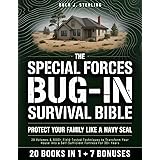In a world where conventional tools and resources may become scarce, the ability to craft essential items from natural materials becomes paramount. The video above powerfully demonstrates the practical construction of a primitive weapon, emphasizing resourcefulness in a hypothetical “zombie apocalypse” scenario. Such skills are not merely for fictional crises; they represent fundamental bushcraft knowledge that can be invaluable in various wilderness or survival situations.
Understanding how to create tools and weapons from your surroundings is a cornerstone of self-reliance. This detailed guide expands upon the principles shown in the video, providing further context and techniques for those interested in primitive survival weapon crafting.
Crafting a Primitive Survival Weapon: Essential Skills for Any Apocalypse
The concept of creating a primitive survival weapon often evokes images of ancient humans or survivalist heroes. However, the fundamental techniques involved are highly relevant for modern individuals seeking to develop their self-sufficiency. A well-made primitive weapon can offer crucial advantages for defense, hunting, or processing materials when no other options are available.
Careful consideration must be given to both the chosen materials and the construction methods. The process demands patience, observation, and an understanding of natural properties, which are all vital survival traits.
The Art of Primitive Weapon Crafting
Primitive weapon crafting is a skill that has been refined over millennia, reflecting humanity’s innate drive for survival. It involves the meticulous selection and preparation of natural resources found in the immediate environment. The creation of such tools is not just a practical endeavor; it is also an exercise in ingenuity and problem-solving.
This art form requires a deep connection with the natural world. Consequently, an understanding of local flora and fauna is often developed, which further enhances one’s survival capabilities. Many hours can be dedicated to perfecting these foundational skills.
Choosing Your Materials: Foundations of Improvised Tools
The success of any primitive weapon hinges significantly on the quality and suitability of its components. Materials must be carefully selected to ensure durability, effectiveness, and ease of processing. Each element serves a critical purpose in the overall design and functionality.
For instance, the shaft of a spear requires straight, strong wood that is resistant to splitting. Points must be capable of penetrating, while bindings need to hold securely under stress. Furthermore, a knowledge of local plant life is instrumental in identifying appropriate resources.
Selecting the Shaft
A sturdy, straight branch is typically chosen for the main shaft of a primitive weapon like a spear or club. Woods such as ash, oak, or hickory are often preferred due to their inherent strength and flexibility. These woods are known for their resilience and ability to absorb impact, which is essential for weapon construction.
The branch should be relatively free of knots and imperfections that could compromise its integrity. It is important that bark is removed and the wood is sometimes fire-hardened for increased durability. This preparation helps to create a long-lasting and reliable tool.
Crafting the Point or Blade
For the business end of a weapon, a sharp, durable material is required. Stone, bone, or even fire-hardened wood can be effectively used to create a formidable point. Flint knapping, a primitive method of shaping stone, allows for the creation of incredibly sharp edges.
Alternatively, the tip of a wooden shaft can be carved to a sharp point and then passed through fire. This charring process, known as fire-hardening, significantly increases the wood’s density and makes it much more resistant to blunt force and wear. Subsequently, the charred layer is scraped off, revealing a harder wood beneath.
Securing with Natural Adhesives and Bindings
The secure attachment of components is critical for the weapon’s effectiveness. Natural resins, such as pine pitch, can be heated and mixed with animal fat or charcoal to create a powerful adhesive. This sticky mixture provides excellent bonding strength for attaching stone points to wooden shafts.
In addition, strong natural fibers are required for bindings. Sinew from animals, plant fibers like nettle or yucca, or even thin strips of rawhide can be effectively used to tightly secure the weapon’s components. These bindings are often wrapped over the adhesive to provide further mechanical strength and prevent separation.
Essential Steps in Primitive Weapon Construction
The construction process for a primitive survival weapon, as demonstrated in the video, involves several key stages. Each stage must be executed with precision to ensure the final product is both effective and safe for use. Attention to detail throughout is paramount for optimal performance.
A systematic approach is always recommended when creating tools under pressure. This ensures that no critical steps are overlooked, which could compromise the weapon’s integrity.
Shaping the Components
Initially, the chosen wood for the shaft must be debarked and straightened. This often involves careful scraping and potentially heating the wood over a fire to bend it into a more linear shape. The process ensures a balanced and manageable weapon base.
Concurrently, the material for the point or blade is shaped using primitive tools. Stone points are flaked to create sharp edges, while wooden tips are carved and then fire-hardened. This meticulous shaping prepares the individual parts for assembly, which is a crucial phase of the process.
Assembling with Adhesive and Binding
Once all components are shaped, they are carefully assembled. The prepared adhesive, such as pine pitch glue, is heated until pliable and then applied generously to the joint where the point meets the shaft. This ensures a strong initial bond.
Subsequently, the natural fiber bindings are tightly wrapped around the joint, often in a crisscross pattern, providing additional structural support. The binding material is usually wet or pliable when applied so it can shrink and tighten as it dries, creating an incredibly secure connection. This method ensures the weapon can withstand significant force.
Beyond the Basics: Other Primitive Survival Weapons
While the video focuses on a sharp-tipped primitive weapon, the range of improvised tools extends much further. Various other designs can be considered, each offering unique advantages depending on the specific survival situation. Expanding one’s knowledge of these options can significantly increase preparedness.
Different materials and techniques allow for the creation of diverse tools, which is why a basic understanding of several types is beneficial. Consequently, resourcefulness is vastly improved by knowing various primitive technologies.
The Primitive Club
One of the simplest and most effective primitive weapons is the club. A heavy, dense piece of wood, often with a natural knot or root ball for increased impact, can be used. It is primarily used for blunt force trauma, which is effective for self-defense or dispatching small game.
Fire-hardening can also be applied to a club for added durability and weight. Wrapping the handle with sinew or rawhide can improve grip and reduce slippage. This basic weapon requires minimal construction, which makes it quickly deployable.
Bow and Arrow Systems
For projectile force, the primitive bow and arrow system represents a significant advancement. Crafting a functional bow involves selecting a flexible yet strong piece of wood, such as osage orange or hickory, and shaping it carefully. The bowstring can be made from animal sinew, rawhide, or strong plant fibers.
Arrows are typically made from straight shoots, fletched with feathers for stability, and tipped with stone or fire-hardened wooden points. Mastering this system requires considerable practice but offers excellent hunting and defensive capabilities from a distance. Therefore, it is a highly valued survival skill.
Developing Your Bushcraft Skills for Preparedness
The construction of a primitive zombie apocalypse weapon, as demonstrated, serves as a testament to the power of bushcraft skills. These skills encompass a wide range of abilities, from shelter building to foraging and fire starting. They collectively form a robust foundation for self-reliance in any survival scenario.
Regular practice and continuous learning are essential for developing proficiency in these areas. Engaged learning and hands-on experience are often prioritized for true mastery. Therefore, the ability to make a primitive survival weapon is a valuable skill in your bushcraft repertoire.











